New highs in employment: Construction, Professional & Business Services, Healthcare, Wholesale trade. Declines in Information.
By Wolf Richter for WOLF STREET.
We discussed overall employment and the number of jobs created in an economy humming along in an inflationary environment. So here we look at a decade of employment trends in each major industry, with employment data by the Bureau of Labor Statistics released on Friday.
The industry categories are by work location. The surveys are sent to employer facilities. The primary activity at that facility determines the industry category. For example, a worker at an Amazon fulfillment center would be under “transportation and warehousing.” It’s not the company that matters, but the work being done at that specific location.
Construction employment (all types, from single-family housing to highways) goes from record to record. Tight availability of skilled labor is still a problem in some sectors, and they’d hire more if they could:
- Total employment: 8.23 million, new all-time high
- 3-month growth: +58,000
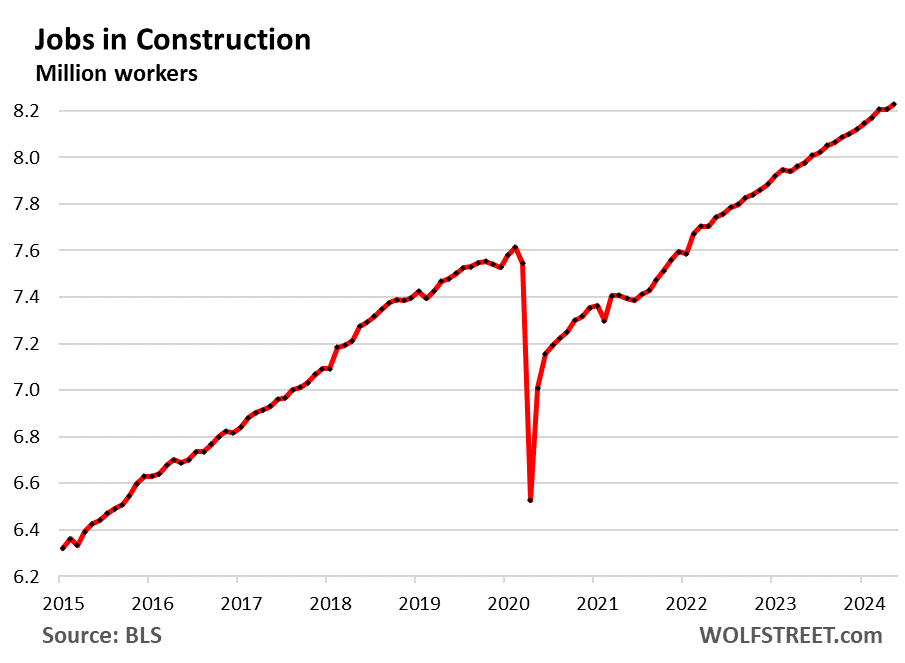
Manufacturing: After a huge surge out of the pandemic, employment has plateaued for over a year at very high levels. Automation rules. Fewer people produce more things:
- Total employment: 12.97 million
- 3-month growth: +8,000
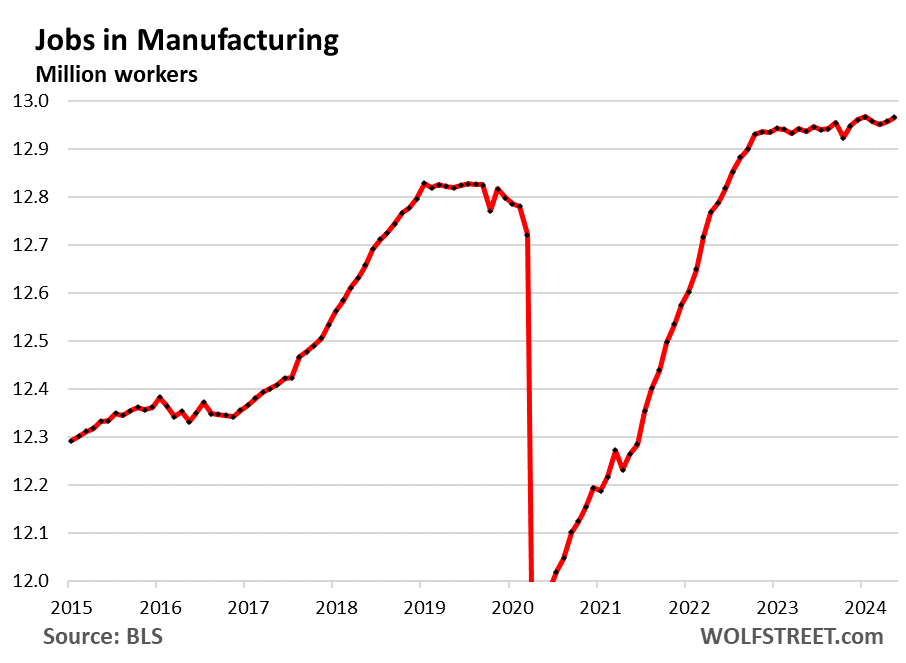
Employment in the largest crude oil and natural gas producing country in the world. As a result of the huge boom in oil and gas production, the US has become the biggest crude oil producer in the world and a net exporter of crude oil and petroleum products; and the biggest natural gas producer in the world and the largest LNG exporter.
And they’re doing it with advanced technologies with fewer workers out on drilling rigs. The oil and gas industry’s tech workers, engineers, traders, finance gurus, managers, etc. are counted in other categories, including Professional, business, and scientific services (see further below).
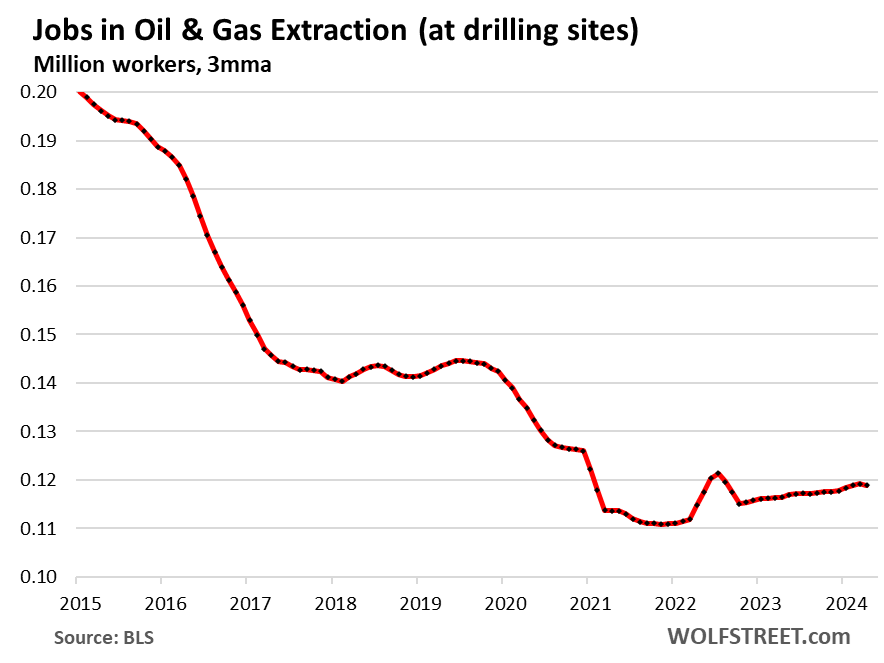
Professional and business services. One of the largest industries by employment, it includes facilities whose employees work primarily in Professional, Scientific, and Technical Services; Management of Companies and Enterprises; Administrative and Support, and Waste Management and Remediation Services. It includes facilities of some tech and social media companies.
The surge in employment coming out of the pandemic has slowed, but employment continues to grow to new records:
- Total employment: 22.95 million
- 3-month growth: +49,000
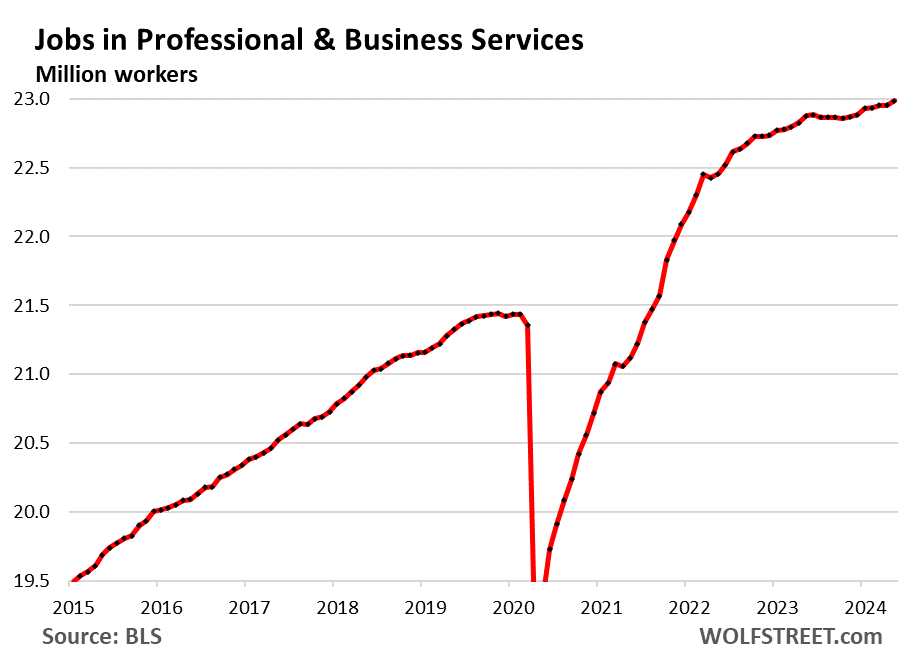
Healthcare and social assistance:
- Total employment: 22.41 million, new high
- 3-month growth: +264,000
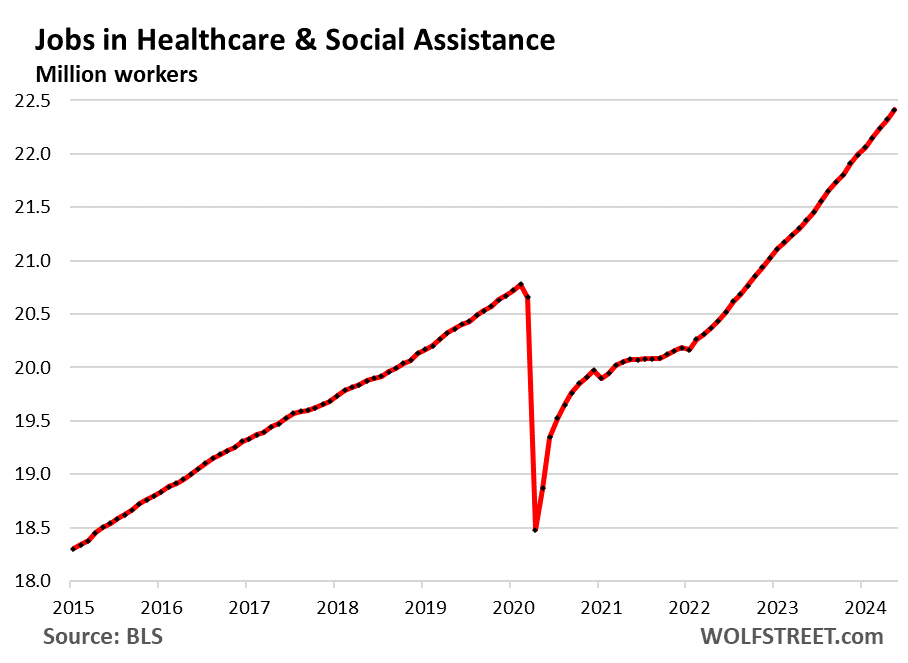
Leisure and hospitality – restaurants, lodging, resorts, etc.
- Total employment: 16.9 million, back at the pre-pandemic high.
- 3-month growth: +108,000
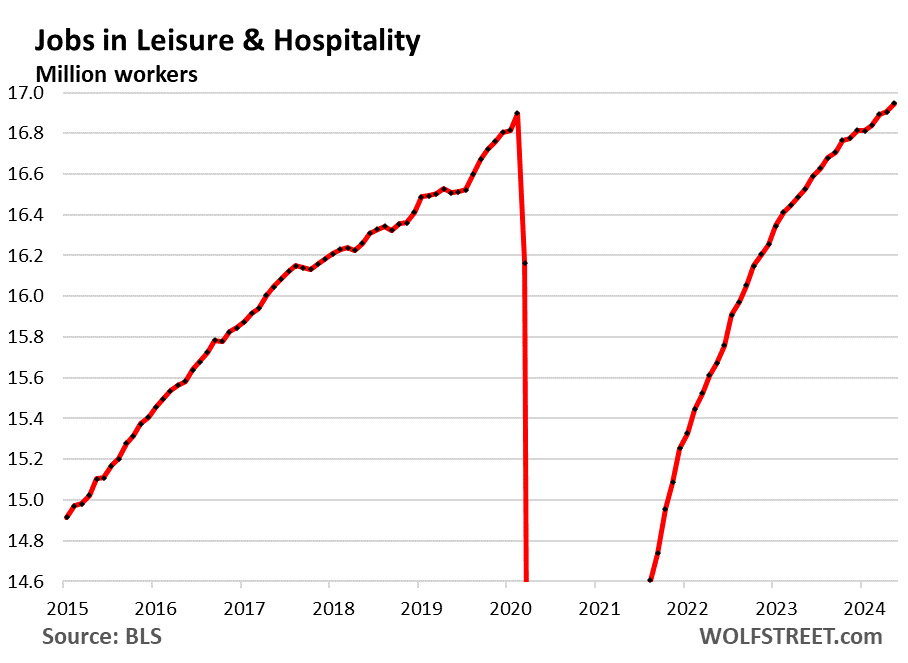
Retail trade counts workers at brick-and-mortar retail stores, such as malls, auto dealers, grocery stores, gas stations, etc., and other retail locations such as markets. It does not include the tech-related jobs of ecommerce operations, drivers, and warehouse employees.
A big portion of this sector has been under heavy pressure from ecommerce operations, and dozens of major retailers have been liquidated in bankruptcy court in recent years, with a total loss of employment, which we have documented in our Brick-and-Mortar Meltdown series.
The retailers that are doing well are those that are selling groceries, auto dealers, gas stations, and others that are not under total pressure from ecommerce.
- Total employment: 15.7 million
- 3-month growth: +55,000
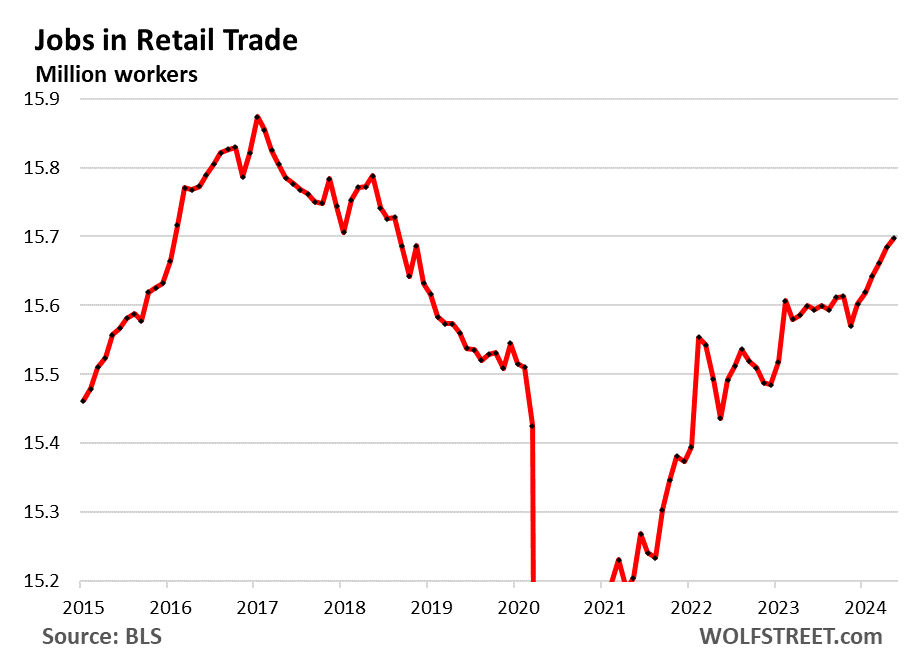
Wholesale Trade:
- Total employment: 6.19 million, new all-time high
- 3-month growth: +14,000
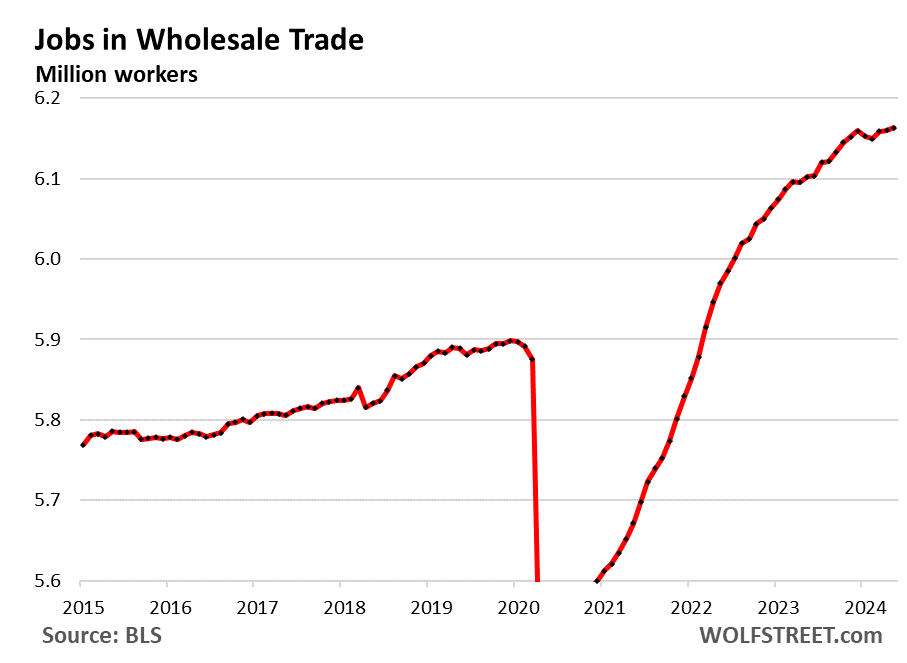
Financial activities (finance and insurance plus real estate renting, leasing, buying, selling, and management). Employment plateaued at very high levels, as the mortgage industry got decimated after the refinance boom collapsed and home sales plunged.
- Total employment: 9.23 million
- 3-month growth: +12,000
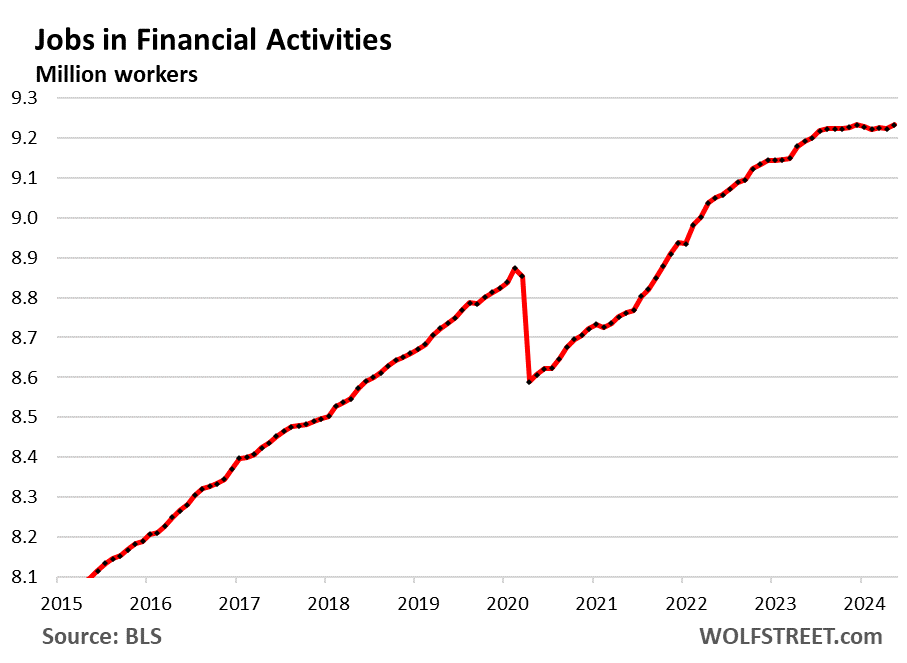
Transportation and Warehousing: Employment surged with the pandemic boom in durable goods, and when that faded as consumers switched back to spending on services, employment began to decline. And then it began to rise up again:
- Total employment: 6.58 million
- 3-month growth: +35,000
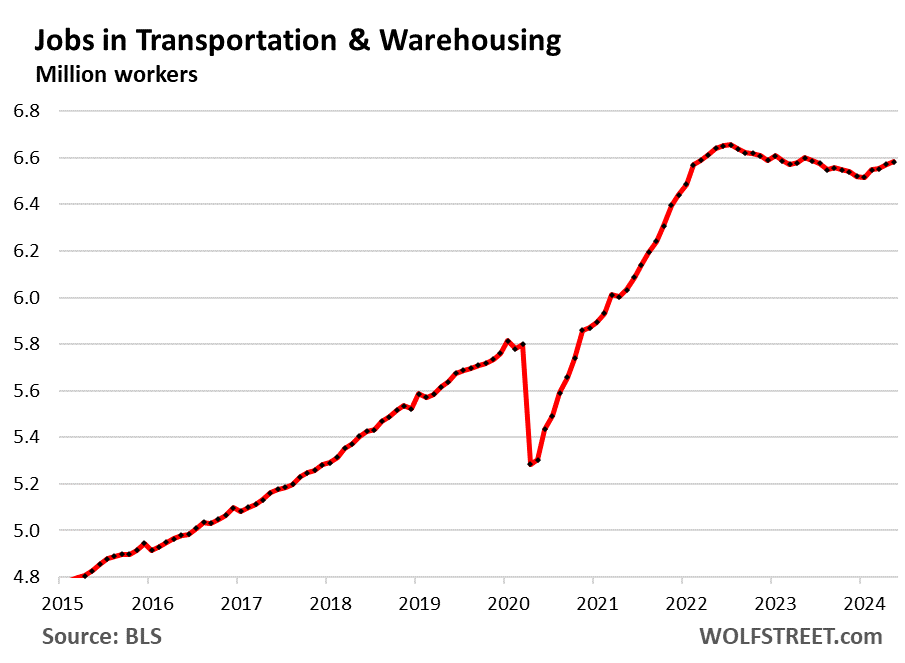
“Information” includes facilities where people primarily work on web search portals, data processing, data transmission, information services, software publishing, motion picture and sound recording, broadcasting including over the Internet, and telecommunications. This includes some work sites by tech and social media companies. You can see the effects of the layoffs.
- Total employment: 3.01 million
- 3-month growth: -3,000
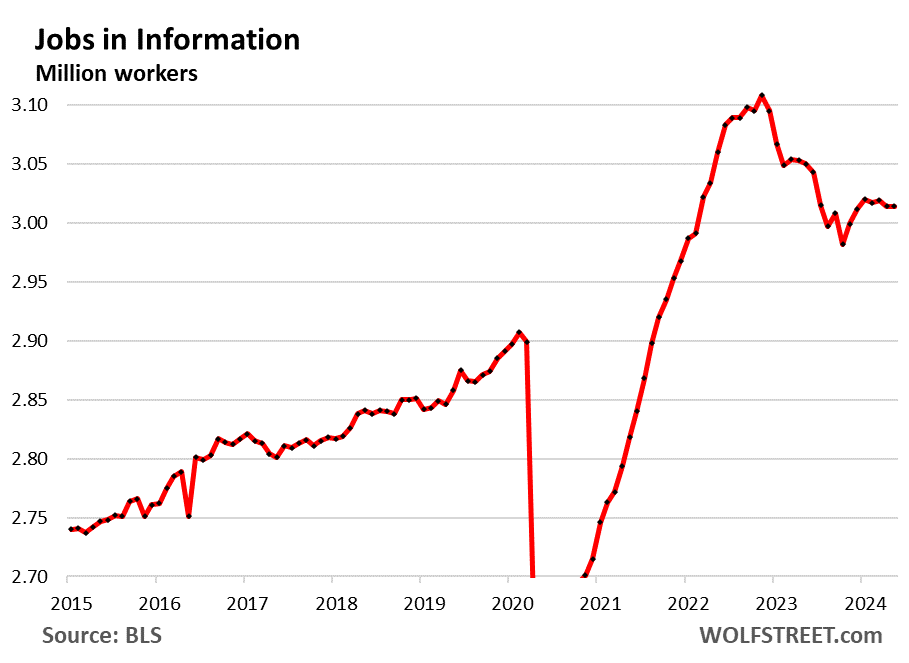
Jobs at federal, state, and local governments: 14.7% of all employees work for governments at all levels:
- Federal government: 1.9% of all employees
- State governments: 3.4% of all employees (including higher education).
- Local governments: 9.4% (much of it in education, such as teachers and school administrators).
As the economy and the labor market have grown over the past 15 years, government employment has also grown, but at a slower pace than overall employment, and so the percentage of government workers to overall workers dropped and reached a multidecade low of 14.5% at the end of 2022. The two spikes occurred during census taking (2010 and 2020) and the second spike was also a result of the simultaneous collapse of total employment during the pandemic.
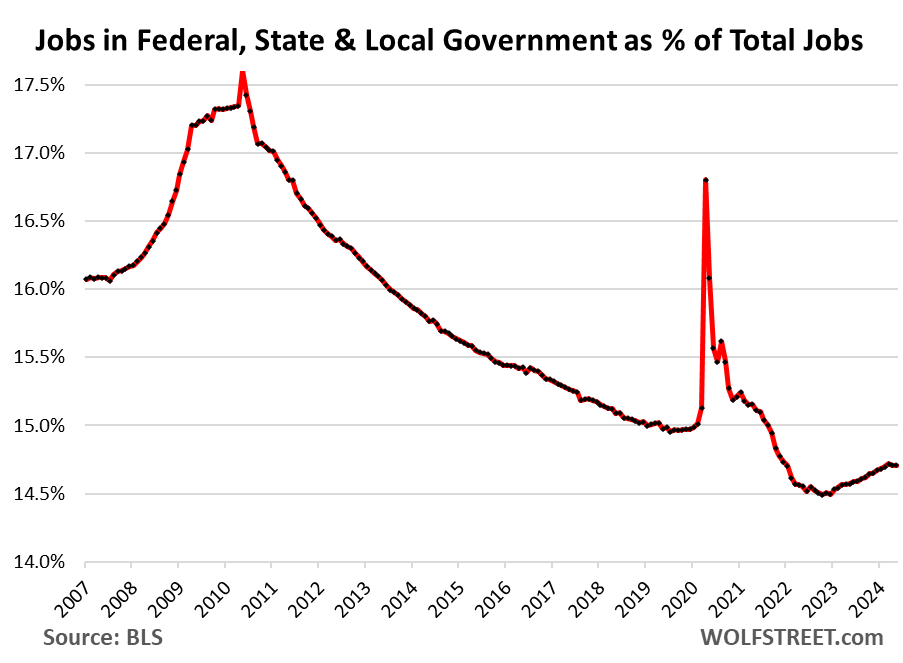
So this is total civilian employment at all levels of government, now nearly back to trend B, not trend A:
- Total employment: 23.3 million
- 3-month growth: +128,000 (+18,000 federal, +110,000 state and local)
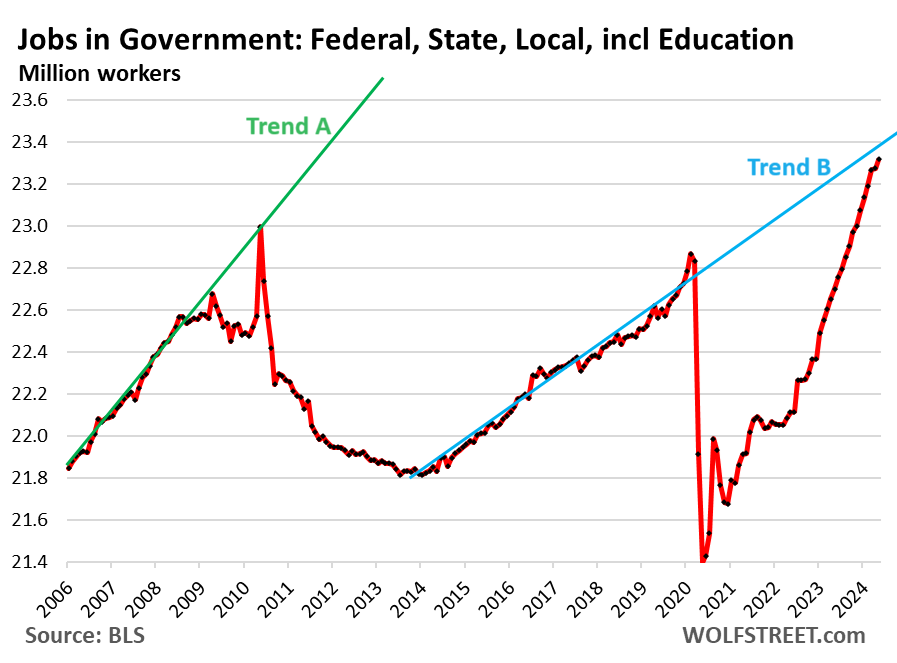
Enjoy reading WOLF STREET and want to support it? You can donate. I appreciate it immensely. Click on the mug to find out how:
![]()


Wolf, this is off-topic and likely hype but you’re the best source for this stuff. I tried searching your past articles and the last one was 2013.
What do you think of BRICS and China dumping US Bonds. Is there really a connection – or is it merely part of the process of China engaging in with US debt, and the media hypes it every chance they can?
Thanks much
China has a capital flight issues and a huge economic problem (the property development sector, a big driver of its economy, as collapsed). Dollars are leaving China and are going overseas for safety reasons. That’s what you’re seeing.
Russia sold its Treasuries in 2014 — not that it mattered because it never had a lot.
Here are the Treasury holdings of a couple of big BRICS members — you see, they don’t go in the same direction.
Wolf you are right about the current state of the Chinese economy. It has a huge problem with the RE development sector, and an even huger problem with local governments debt and shadow banking, which are impacting the consumer confidence and even the banking sector, but still this does not change the fact that the Chinese are the second biggest foreign holders of US debt securities after Japan, which BTW considering the state of its economy and the Yen persistent weakness, doesn’t make it a reliable and stable participant in the US government fixed income market. Considering the continuous selling of US government debt by the second biggest foreign holder, and your last two great articles on employment and the consequences the labor market is having on the inflation, don’t you think that this situation might have an impact on US yields, USD value, and the broader market’s performance in US?
I agree, longer-term yields are heading higher — that’s my guess, but not for the reasons you cite because foreigners in total are still adding to their holdings.
In addition, the importance of foreign holders has been diminishing for years. They’ve been buying more debt, but the debt has been rising at a faster pace than they were buying, and so their share has dropped for many years, and by a whole lot. See second chart below.
I’ll just repost a section from this article, with data through October (seems I need write another update on this):
https://wolfstreet.com/2023/12/20/are-foreign-holders-finally-bailing-out-of-the-incredibly-ballooning-us-national-debt/
Foreign holders in aggregate have kept their holdings of US Treasury securities roughly stable for the past two years. In October, their holdings dipped to $7.56 trillion, up about 6% from a year ago, but the same as in June 2021, according to TIC data from the Treasury Department released Tuesday afternoon (red line in the chart below)
Foreign holders have not kept up buying the incredibly ballooning US government debt, and as a result, the share of their holdings has plunged to a share of 22.4%, from the range of around 33% in 2015. In other words, the US debt financing has become less dependent on foreign holders:
The six largest financial centers – the UK (actually the City of London), Belgium, Luxembourg, Switzerland, Cayman Islands, and Ireland – reduced their holdings a little in October, after the record in August, to $2.22 trillion
These countries specialize in handling and often obscuring the financial holdings of global companies, individuals, and governments. Ireland is a favorite for US companies to store their profits:
Dear Wolf, Don’t you mean that foreign economies, e.g., China’s, are in deep guano so will not be able to buy as many treasuries. Also, don’t companies “store their profits” (like Gizmodo reports as to Apple’s $50 billion) in foreign tax shelter countries, to avoid paying US/EU taxes?
RH,
Yes, to your #2. See the blue line, now over $2 trillion, for the six largest financial centers (first chart in my reply right above yours).
If China wishes to take massive losses and sell its treasuries holdings immediately, please do it! LOL Already, with the oncoming, news about EU and other tariffs on Chinas, and slow, RE collapse, etc., China will not be able to keep as many treasuries anyhow. US companies invested in China will also eat dust! Maybe, bite it.
Of course, that does not mean that we should not support the truly honorable, Rep. Massey’s bill to End the Fed to prevent it from destroying the value of treasuries, whose few, legitimate functions can be performed by a truly Federal, independent, government agency. Like a huge blood leech living in a hippo’s (….err) body, the Fed has primarily been a device to suck our (financial) blood since it was created by bankers’ deception of and lies to the US Congress and president. President Wilson long rued the day that he allowed the creation of the Fed-leech. Time to end the Fed-leech!
Also, like the CCP-connected, fentanyl drug lords, the billionaires’ (privately owned via district banks) “Fed” has addicted Americans, meaning US politicians: to reckless spending without raising taxes on the tiny minority of wealthy persons who have paid almost 0% in taxes for many decades. See Warren Buffet’s honest statements as to paying less taxes than his secretary.
We must End the Fed, before it ends or at least, crashes our economy. Persons like Powell would be free to act only in the best interests of Americans if he/they headed a purely Federal agency, owned only by the American people, not by a billionaire, banker aristocracy whose wealth he may get incentives to preserve. Note reports that a former, Fed leader was getting $200,000 to $400,000 per boring, droned speech years ago! Reward?
Nah… the fed isn’t the problem. The problem is what the fed is doing. Money needs to retain value and therefore interest rates should have a declared floor. When you make interest rates 0 for so long, money is effectively worthless and it starts chasing all sorts of ridiculous things because the hurdle rate is so low. If money costs 5% – the market returns 8-10% and owning a business returns 12-15% everything is right in the world. When money costs zero, lower the hurdle rate by the same for each of those. The fed should just provide liquidity when the system breaks.
What do you think the reason for trend A and B? I find this very interesting.
Wouldnt be surprised that trend B becomes A, with a good amount of immigration and my part of the milenials (between 30 to 34) poping kids left and right.
First and foremost, I want to express my gratitude for the valuable work you’re doing. I’ve recently delved into your two latest articles discussing employment and job trends, and they’ve certainly sparked some intriguing thoughts. Have you had a chance to review the revised data from the Bureau of Labor Statistics (BLS)? In their press release dated April 24, 2024, concerning the Third Quarter of 2023, they stated, “gross job gains from opening and expanding private-sector establishments were 7.6 million, a decrease of 561,000 jobs from the previous quarter. The difference between the number of gross job gains and the number of gross job losses yielded a net employment decline of 192,000 jobs in the private sector during the third quarter of 2023.” This revision reflects a staggering difference of over 700,000 fewer jobs compared to the original release.
Additionally, the BLS highlighted that “in the third quarter of 2023, gross job losses represented 5.9 percent of private-sector employment.” Given that this information stems from the same organization you referenced in your recent articles, why isn’t this discrepancy making headlines? It’s a crucial aspect of understanding the employment landscape that deserves more attention and analysis.
Get ready for a geek-headache, 🤣. But you brought it up. Not me.
You’re citing the Business Employment Dynamics (BED). It’s a different thingy that the BLS does quarterly. And it’s based largely on state unemployment insurance data, and it’s always different.
The report you cited was released in April for Q3 2023. This is the link:
http://www.bls.gov/news.release/archives/cewbd_04242024.htm
1. Step: Scroll down and read the “Technical Note.”
Paragraph 1 of Technical Note: methodology (it’s UI based).
“The Business Employment Dynamics (BED) data are a product of a federal-state cooperative program known as the Quarterly Census of Employment and Wages (QCEW). The BED data are compiled by the U.S. Bureau of Labor Statistics (BLS) from existing QCEW records. Most employers in the U.S. are required to file quarterly reports on the employment and wages of workers covered by unemployment insurance (UI) laws and to pay quarterly UI taxes. The QCEW is based largely on quarterly UI reports which are sent by businesses to the State Workforce Agencies (SWAs). These UI reports are supplemented by two additional BLS data collections to render administrative data into economic statistics. Together these data comprise the QCEW and form the basis of the Bureau’s establishment universe sampling frame.”
Paragraph 2 of Technical Note: use of these reports:
“These reports are used to produce the quarterly QCEW data on total employment and wages and the longitudinal BED data on gross job gains and losses. The QCEW is also the employment benchmark for the Current Employment Statistics (CES), Occupational Employment Statistics (OES), and Job Openings and Labor Turnover Survey (JOLTS) programs and is a major input to the Bureau of Economic Analysis’s Personal Income Accounts.”
BTW, the jobs report that came out on Friday is part of the Current Employment Statistics (CES).
Paragraph 4 & 5 of Technical Note: Differences between QCEW, BED, and CES employment measures
“The Bureau publishes three different establishment-based employment measures for any given quarter. Each of these measures—Quarterly Census of Employment and Wages, Business Employment Dynamics, and Current Employment Statistics—makes use of the quarterly UI employment reports in producing data; however, each measure has a somewhat different universe coverage, estimation procedure, and publication product.
“Differences in coverage and estimation methods can result in somewhat different measures of employment change over time. It is important to understand program differences and the intended uses of the program products. (See table.) Additional information on each program can be obtained from the program websites shown in the table.”
There is a lot more in the Technical Note, and if you really feel like getting a geek-headache, it’s worth reading. All this stuff is interesting but complicated. So enjoy, it’s a Saturday, and there’s no better way to spend a sunny Saturday than geeking out over BLS data?
The amount of research and effort you put into each article puts the entire media and especially the financial media to shame. Keep up the excellent work.
A lot of the “media” doesn’t exist to inform, it exists to publicize a politically determined narrative under the guise of “informing”.
That’s why multiple info sources are crucial and the internet indispensable.
The old media oligopoly “watchdogs”/”gatekeepers” oversaw the decades that took the US from a position of unassailable economic dominance to debt crippled, inflation finance incompetence.
+1 to Seth
Where does legal services fit? My impression is that litigation is becoming a bigger and bigger industry.
Professional and business services.
I just giggled a nervously when I thought about professional and business services taking 56 billion from healthcare per year. 56 billion ish dollars a year just in medical litigation. 53000/year per physician (1 million ish physicians) per year way over simplified as hospitals etc pay too… just one sector. I wonder how much goes to the lawyers/professional services…Small money in the grand scheme of healthcare costing 4.5 trillion ish per year in our country except the rest of the practice of medicine is way overspending attempting to guard against being a piece of that 56 billion. Is there a way I can invest in litigation?
PE and hedge funds already invest pools of money to support litigation with the intent of sharing in profits. PE is also investing directly in law firm ownership in AZ, the only state which allows corporate ownership of law firms.
No economic impact monte
Normally I would find this mildly disturbing to say the least,eating food off of a naked stranger,but,in todays world that really would not raise a eyebrow but would chose another eatery.
It’s been around for a long time.
And in all honesty, I had to look it up.
I’m a henway.
“What’s a henway” you ask?
“’bout 2 0r 3 lbs.”
This comment was in train of similar comments now deleted. It should have been deleted also.
Yes, your comment somehow got orphaned. The reason the original comment (and automatically with it all replies except yours) got deleted was the sex-comments it triggered. I was just waiting for that. I knew it would happen sooner rather than later. And it did. Human nature. The original comment was weirdly sexual and didn’t belong here anyway.
I never got the job, they said I was to old and ugly and my teeth were rotten.
Now, older folks bring something to the work force that the youth can’t match, I can’t remember what it is but…
Let me just say that some of the older people are absolutely priceless in spirit and understanding. If your an employer, get a few geezer on the payroll, don’t get the stubborn mule type or the ones with the blinders on, but get the open minded, well seasoned geezer in relative decent condition.
I see. Thank you, Wolf.
People with technical skills are busy…
Home toad – you are , officially, creepy, ….
The IMF strongly told the US to get its HOUSE OF DEBT in order before it all comes crashing down on the bald head of the US.
My fortune 15 company just initiated a 5% layoff with many teams being demoted and moved offshore. This is one of three planned RIFs. This came on the toes of many others that we know.
I hope you will be spared.
In 2018-2019, in an average month, 1.8 million people were involuntarily discharged, including layoffs. This is standard American business practice. Happens all the time.
Thank you! I was told, by others, it’s is a 3 year cycle that was paused due to 2020. Glad you could confirm that.
GC – Much of the previously offshored work is now going to AI. If you can send input to a faceless individual overseas to provide output, it can just as easily be sent to a computer with the same result. The countries that provide much of those services are going to be hit hard.
Twice as many people work in Government than in manufacturing in the USA.
In my opinion this is not a good ratio as Government employment requires taxes of others
Manufacturing is mostly automated. Big plants produce a lot with relatively few people but LOTS OF EXPENSIVE EQUIPMENT. Most of the employment in government is in education: teachers, college instructors, college professors, administrators, etc. Do you want education — from grade schools to state universities — be replaced by machines? That may eventually happen, but then good luck.
This actually raises an interesting question– a lot of grade school through general education college courses could easily be done via online study modules with essays graded by online instructors.
The cost savings would be tremendous, and it isn’t even clear that quality would really be any lower than what is currently on offer (especially if you think back to some of the classes in high school or GE college classes).
Do you see something like this coming? Seems to me the only barrier is social acceptance.
My kids come home commenting on what their teachers did or said at least twice a week. They definitely value the engagement. The good teachers know how to assess the room and push the right buttons.
In terms of colleges, yes, they should be in drab government office buildings, they should sell their huge real estate holdings, and they should hold theoretical classes online. Tests, lab work, a few classes (such as once a week), etc. can be done in the drab government office buildings. It would save students and parents a huge amount of money. But the educational-industrial-financial complex won’t ever let it happen. It would be good use for some of the nearly worthless office towers now standing empty.
But I agree with Bobber, younger kids need teachers in person, they need role models, they need peers, they need to be there and learn in a social setting, and learn how to behave in social settings, and how to form bonds in social settings. They can do homework at home.
I think this overlooks the social aspects of education and values education as something that only benefits the workforce. There are many societal values to education as well (but I won’t get into them because I don’t want to start a political argument)
Human interaction is extremely beneficial at all levels of education, not just school education, but in all realms of life. There is no substitute for an inspiring teacher who takes an interest in you and serves as a valued mentor. While the Internet is great, and people like Wolf are priceless educators, it is also important to meet and interact. Much human progress gets made through BS sessions and “brainstorming”, not just by structured, canned online classes. I ran a large national chain of after-school learning centers for advanced students in math. As Wolf points out, the human interaction is immensely powerful and drives learning for these kids.
Interesting idea. AI teachers. But what to teach? Political ideology?
The most important thing I discovered about learning was that most of what I need to know I can teach myself. Just needed to be taught Reading Writing Speech Mathematics Finance.
Most schooling today is forced memorizing and being tested for memory retention. It’s a rare educator who teaches students to think and problem-solve independently.
Students today are programmed to be good little Feudal Vassals.
He who controls the teacher bots controls the destiny of the nation.
Here in NJ, non-union construction workers have no trouble earning over $100k per year, even as handy-men/women. I know one person who runs a handyman service who has to pay his good workers over $50 per hour to keep them. The people like myself who used to do our own repairs are either too old to continue or have no interest or ability. Young people largely (around here) have no ability or no interest in doing their own repairs/projects So there’s a huge demand. A simple job for a plumber easily turns into a $2000 job that takes about 4 hours.
Excellent point. I have heard the same from many owners of small businesses in the trades. If our country wants to “re-shore” industry, we need people that are willing to use both their minds and their hands. The U.S. also desperately needs more immigration. Most immigrants are highly motivated and want to work.
Wolf,
Do you think we will ever see a bona fide business cycle recession again?
By this I don’t mean a government created boom bust cycle (like COVID or even the 2022 interest rate increases caused slowdown).
It seems that all of the business school macro economic type stuff you would learn doesn’t work anymore because everything is predominantly based on government policy.
For example, there has been very minimal antitrust enforcement, so there are fewer free market dynamics. Additionally, there are bailouts of too big to fail companies, and smaller backroom bailouts coordinated by the Fed or other government entities.
Do you think we are moving in a direction where market action is driven more by factors like those existing in the People’s Republic of China than what we have previously seen in the US?
A lot of people (myself included) have been confused by how things have been progressing over the past few years.
I think it might be time to step back and ask whether the game itself has changed in a fundamental way.
What do you think?
If we look at a historical graph of the unemployment rate we see that the current rate of 4% is way too low relative to history. It is fueling inflation, which is running at twice target, after a 20% “one time” step up. Why is the Fed not increasing its inflation fighting effort given the unemployment rate is well below normal sustainable levels?
Former Fed officials have stated they don’t even know if rates are restrictive. Powell has publicly recognized this uncertainty.
What justifies the Fed’s current level of caution and inaction?
Caution and inaction?
They’re scared of causing another cluster on their watch. Powell and the gang have got SOS, shit on shoe from their last experiment. It might be our debt problems, leaving us zero wiggle room for the franken powell, even a slight breeze can send it all crashing to the ground.
To be honest I have no idea what I’m talking about, I should report in for reprogramming.
The Fed says it’s data dependent, but it seems to be disregarding the two most important data points – employment and inflation.
If the Fed said it was targeting 3-5% inflation, its action or lack thereof would make better sense in my view.
Do you want education — from grade schools to state universities — be replaced by machines?
It might be an improvement over our current system.
Another magnificent report from Wolf. Very detailed reporting, yet also aggregated in a manner that the reader can quickly grasp. As a private investor, Wolf Richter is one of my key “go to” guys when it comes to all things macro. He also shares his frank opinion, which is very refreshing. His opinions are also backed up by solid facts, not hot air. Wolf is the real deal. We all owe him a debt of gratitude and generous, regular donations.
So you do know those construction jobs are jobs done by illegal aliens right? Those are not American filled jobs. As a matter of fact a lot of those so called jobs are done by immigrants both legal and illegal. Reading numbers is a big difference than going out in the real world and seeing reality! It’s all smoke and mirrors and you fall for it hook line and sinker. I can’t believe you actually buy all this BS. I come here to get a laugh from your delusions of grandeur!
“so called jobs are done by immigrants both legal and illegal.”
I’m an immigrant, and US citizen since the 1980s. Musk is an immigrant. Google CEO Pichai is an immigrant. Microsoft CEO Nadella is an immigrant. Nvidia co-founder and CEO Yang is an immigrant. Lots of CEOs are immigrants. What the f**k is your problem?
Illegal immigration is a huge problem. But these people do work, and when they work in construction, that doesn’t make those construction jobs “fake.”